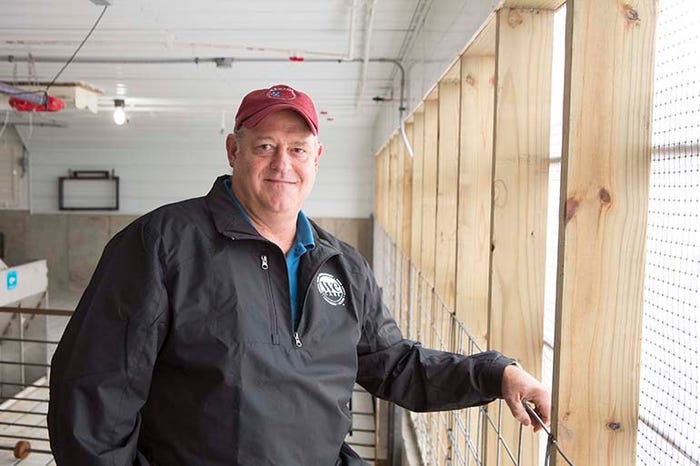Legacy of leadership sets stage for Pork Checkoff 4.0.

Steve Rommereim could not have imagined the places the pork industry would take him when he started raising two sows as an 8-year-old in southeastern South Dakota.
Rommereim, now 59, is wrapping up his year as president of the National Pork Board. Previously, he served on the South Dakota Pork Producers Association board from 2001-11 — one year as president — and the progression was to get involved on the national level. He handed over the gavel to the new NPB president at the board’s meeting this month.
His past year of service has been filled with trade disputes and foreign animal diseases, especially the spread of African swine fever across Asia. This involvement has taken this South Dakota farm boy around the country as well as the globe, all in the name of supporting and promoting pork.
Sounding like the lead character in Dr. Seuss’ “Oh, the Places You’ll Go,” over the years, Rommereim has found himself in Reno, Napa Valley, Arizona and Florida as well as Mexico, Brazil, Colombia, Japan and China — all with the mission of getting U.S. pork on more tables. One commonality that all these places hold is, “People like pork,” he says.
Though Rommereim has more than 50 years’ experience raising pigs, it wasn’t until the 1990s that he started to get involved on the national scene, serving on NPB committees. He was actually following his wife, Charlotte, in involvement on the national scene, as she had been serving on the NPB Nutrition Committee for, “Oh, long before I was on this board. So, she had her foot in the door,” he says.
Charlotte was no stranger to the swine world, as her father, James Leafstedt, is well-known for raising purebred Durocs and Spots until the pseudorabies virus took its toll in his herd. The elder Leafstedt didn’t take PRV lying down, and Steve Rommereim says James “has been called the ‘godfather of pseudorabies.’ He led all the efforts to eradicate it, along with many, many other people. A lot of them are still involved, such as Paul Sundberg [current executive director of the Swine Health Information Center] and Bobby Accord [with the National Pork Producers Council],” Rommereim says.
“I mean, he worked. That whole group of people got this education program off the ground, and James was part of it. … He’s won every award there ever was because of his work around that as a producer. These are all great, really smart people. They were the boots on the ground. They asked themselves, ‘So, what can we do to eradicate this disease that will work for producers?’ Back in those days, it was testing a quarter of your sows. You could test your way out and then, pretty soon, they just minimized it and boom! We didn’t really have any [pseudorabies] left except in feral swine.”
Industry adds to education
Not that Rommereim was pressured by marriage to get involved — he just felt like being involved in the industry at a leadership level was something that he believed in and needed to do. Involvement in the pork industry has also been a way for him to further his education.
He graduated from South Dakota State University in 1983 with — get ready for this — a double major in animal science and meat science, and minors in economics, psychology, ag economics and ag business.
“I loved college,” he says, with a slight understatement. On top of his schoolwork, he also completed his pilot’s license, emergency medical technician certification, “and I was fooling around with taekwondo” — as well as being on the SDSU meats judging team. He squeezed that full load into four-and-a-half years in Brookings. “I graduated with 183 credits. I only needed 128.”
As mentioned earlier, his involvement with national leadership was with the NPPC on committees and as an NPPC delegate at the annual Pork Industry Forum.
The swine industry is a small but proud crowd, and Rommereim was approached by Chris Novak, who was CEO of NPB at the time, who suggested that Rommereim come over to the Pork Checkoff side. The industry had two distinct callings: the National Pork Producers Council managing legislation and issues, and the Pork Checkoff leading the industry’s promotion, education and research.
Novak “wanted me to run,” he says, “and we had 14 people running that year, but he [Novak] said, ‘It’ll be great experience. I know you’re interested in these things.’”
Well, he didn’t get on the National Pork Board that first year, but came back the next year, made the cut and was approved by then-USDA Secretary Tom Vilsack. “At that time, to be perfectly honest, you’re just trying to keep up because the fire hose is pretty big, especially when you have fiduciary responsibilities of around $77 million of other people’s money.”
Once on the board, he then felt responsibility to move up in leadership ranks. In his third year, he ran for and was named treasurer. “It’s not typical that you, in your first one or two years, run for an officer spot, because you’re still learning your way around,” he says.

Handling it all
Knowing that serving as an officer would take even more time away from Highland Swine, his farm in Union County, S.D., he couldn’t take on this commitment without other pieces falling into place. For this he credits Brian Fatherless, who came on as a hired man about three years ago.
“He has allowed me to do what I’m doing, and I’m very grateful to him for it, and he loves it.” Highland Swine finishes about 12,000 hogs annually. The Rommereims are also part owners in SDI Pork LLC, which finishes 120,000 hogs each year.
Steve and Charlotte live on the farm where she grew up, which was homesteaded in 1874. Steve grew up near Norway Center, S.D., and it was “16.2 miles from where my wife grew up to my place. I knew it because I drove it fairly often,” he explains.
Steve and Charlotte also have two grown daughters — Leah (Josh) Gradert and Lara (Matt) Fodness — allowing him to give his time to the pork industry while not missing out on his daughters’ activities. This is the second spring that Rommereim has rented out his farmland to son-in-law Josh, also freeing time for NPB commitments. Who knows, maybe grandsons Milo and Jameson will someday become the seventh generation to live off the land in Union County in southeastern South Dakota.
Rommereim will serve another year as past president, and possibly continue to serve on committees, but he is ready to hand over the reins and cut back on his travel — at least pork-related travel. He sees a trip with Charlotte in their future.
As he looks back on his time with the NPB, and the past year as president, he’s going to miss the people whom he got to know and work alongside. “There are just a lot of great people, who are all passionate about their industry,” he says. “I am going to miss working with them, but I’m really going to miss working so closely with Bill Even, NPB CEO.
“What I’m going to miss the most, to be perfectly honest, is the kind of direct relationship I have right now with Bill,” a relationship that goes back a few years. Even served as the South Dakota secretary of agriculture 2007-10, overlapping Rommereim’s term as president of the South Dakota Pork Producers Association. “He’s just a tremendous guy.”
Since Even came on board to the NPB, Rommereim credits him with leading the Pork Checkoff in evolving to remain relevant for its producers.
“He’s extremely visionary, extremely strategic. And that’s a hard place to get to when you farm for a living or raised livestock, because everything we do is tactics all day long. We’re fixing problems, we’re deciding what to buy, what to do, where to go,” Rommereim says. “It’s all tactical, and maybe a couple times a year when you’re sitting, going over books, then started thinking strategic about, ‘All right, what do I want this thing to look like in five years?’
“I’m going to miss that direct contact with Bill because we worked very well together, having known each other for 10 or 12 years,” he says.
Legacy of leadership drives relevance
The Pork Checkoff will continue to evolve, and Rommereim feels proud in that his legacy will include getting the development of the latest version of the Pork Checkoff strategic plan off the ground.
“With Bill Even at the helm, we’re going to redesign [the National] Pork Board based on being relevant,” Rommereim says, noting the challenge is meeting producer needs not only today, but also over the long term. “It’s a big ship to try to turn. Part of our strategic plan now is to get us more nimble” he says. “If you look at large producers like Smithfield or Pipestone, they do their own research. So where does that leave us, with one of our mandates as research?
“We have to be researching the things that people aren’t, or at least do it in conjunction with some of these large companies. But that model doesn’t exist. Our current model is unchanged since 2001; it’s the same Pork Board. We’ve been calling that [Pork] Checkoff 3.0, so now we’re entering 4.0.”
A draft of the Pork Checkoff 4.0 strategic vision was be seen by the executive board at its meeting this month — Rommereim’s last as president — with a final plan to be voted on by the board at its September meeting in Sioux Falls, S.D.
“The industry has changed a lot since 2001, and so the pork board needs to change to keep pace with the industry. To me, that’s going to be the most important thing that I’ve been involved in, besides just doing the regular business, keeping the budget right and all the other things that we do as pork board members,” he explains.
Rommereim uses “we” an awful lot when speaking of the work the National Pork Board has done while he’s been involved, and he also uses “we” when speaking of things future NPB members will accomplish, indicating his pork industry involvement will not end when he last bangs the gavel, ending his presidency.
About the Author(s)
You May Also Like



